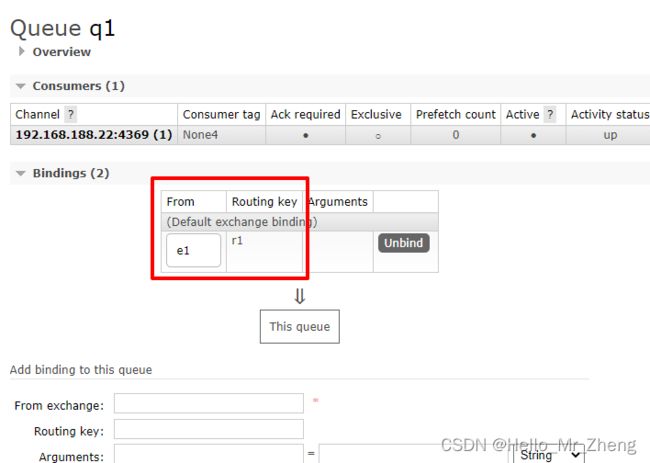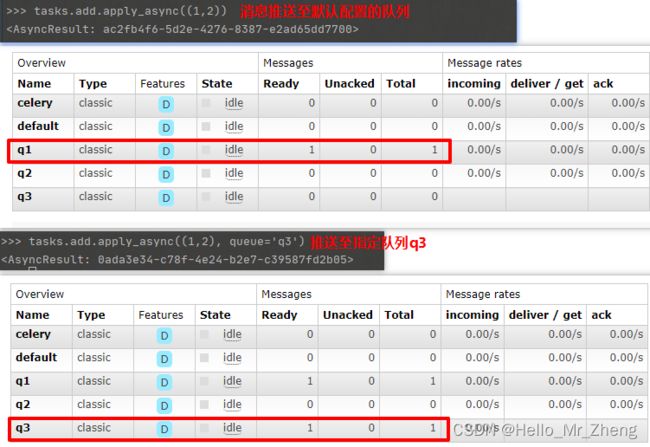django+celery+ RabbitMQ自定义多个消息队列
关于django celery的使用网上有很多文章,本文就不多做更多的说明。
本文使用版本
python==3.8.15
Django==3.2.4
celery==5.2.7
celery.py
from __future__ import absolute_import, unicode_literals
import os
from celery import Celery
from kombu import Exchange, Queue
# set the default Django settings module for the 'celery' program.
os.environ.setdefault('DJANGO_SETTINGS_MODULE', 'zkcelery.settings')
app = Celery('zkcelery')
# Using a string here means the worker doesn't have to serialize
# the configuration object to child processes.
# - namespace='CELERY' means all celery-related configuration keys
# should have a `CELERY_` prefix.
app.config_from_object('django.conf:settings', namespace='CELERY')
# Load task modules from all registered Django app configs.
app.autodiscover_tasks()
# 看了一篇文章说,如果使用redis做broker,exchange可以不配置;但如果使用rabbitMQ做broker,就必须要配置。
queue = (
Queue('default', exchange=Exchange('default', type='direct'), routing_key='default'),
Queue('q1', exchange=Exchange('e1', type='direct'), routing_key='r1'),
Queue('q2', exchange=Exchange('e2', type='direct'), routing_key='r2'),
Queue('q3', exchange=Exchange('e3', type='fanout'), routing_key='r3'),
)
# 一旦配置了route后,所有的任务名都必须要指定route,否则任务无法执行。
# 经过测试,route匹配是最长匹配规则。
route = {
'apps.zhiding.tasks.add': {'queue': 'q1', 'routing_key': 'r1'},
'apps.zhiding.tasks.multiply': {'queue': 'q2', 'routing_key': 'r2'},
# 其它的任务名称,匹配这条路由
# 如果以上队列的worker服务器坏了,这些任务会被全部放进这个队列里,该队列的worker将继续处理这些任务
# 下面这条队列一定要配置,否则其它任务无法处理。
'*': {'queue': 'default', 'routing_key': 'default'},
}
app.conf.update(CELERY_QUEUES=queue, CELERY_ROUTES=route)
tasks.py
from celery import shared_task
import time
@shared_task
def add(x, y):
time.sleep(2)
print('任务睡眠2秒后执行了')
return x + y
@shared_task
def multiply(x, y):
time.sleep(5)
print('任务睡眠5秒后执行了')
return x * y
@shared_task
def sub(x, y):
time.sleep(4)
print('任务睡眠4秒后执行了')
return x - y
笔者也看了很多博文,在settings.py配置文件中写入CELERY_QUEUES和CELERY_ROUTES,上面的配置对应下来就是如下代码块:
CELERY_QUEUES = (
Queue('default', exchange=Exchange('default', type='direct'), routing_key='default'),
Queue('sq1', exchange=Exchange('sq1', type='direct'), routing_key='sq1'),
Queue('sq2', exchange=Exchange('sq2', type='direct'), routing_key='sq2'),
Queue('sq3', exchange=Exchange('sq3', type='fanout'), routing_key='sq3'),
)
CELERY_ROUTES = {
'apps.zhiding.tasks.add': {'queue': 'sq1', 'routing_key': 'sq1'},
'apps.zhiding.tasks.multiply': {'queue': 'sq2', 'routing_key': 'sq2'},
'*': {'queue': 'default', 'routing_key': 'default'},
}
但是笔者在实际使用中发现后面这种方式配置始终未生效,不知道是不是笔者版本的不同,没有做更多的研究。不过建议大家使用小写的配置,因为官方文档下介绍在6.0后将移除旧的配置,具体说明截图如下:

启动worker
# 笔者使用的windows,启动时需要加上-P eventlet
celery -A zkcelery worker -l info -P eventlet
启动后队列中出现配置中的个队列

同时会在rabbitmq中创建(如果不存在)4个队列,交换机和相应的绑定关系(当然也可以直接通过rabbitmq管理端直接创建自己需要的队列、交换机和绑定,具体根据个人习惯或者视工作场景而定选择)

以队列q1示例:

暂时先关闭worker,便于观察消息队列中的消息。
向队列中发送几条消息,消息均进入到配置中指定的queue中

再次启动worker,队列中的消息立马被消费

如何做到消费指定的队列中的消息,只需要启动的时候加上参数Q
# -Q指定消费的队列
# -n 指定worker节点的名称,避免启动多个时的重名冲突
celery -A zkcelery worker -l info -Q q1 -n node1 -P eventlet
可以看到终端中queues只有q1了

q1中的消息被消费掉了,其他队列没有变化

也可以同时指定多个消费队列
celery -A zkcelery worker -l info -Q q2,default -n node2 -P eventlet

